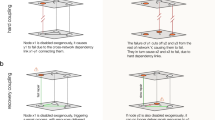Abstract
Critical infrastructures are defined as systems and assets, whether physical or virtual, so vital to the nation that their incapacity or destruction would have a debilitating impact on the nation’s existence. Although composed of systems that are usually designed/implemented independently, critical infrastructures are in reality interdependent: hence risks/failures will often cascade from one system to another. In this paper, we derive an efficient procedure to fully describe the cascading effects of a node failure in a network of interdependent systems. The procedure is solely based on operations on the adjacency matrix of graph representing the network. We have also shown that the analysis of the cascades can be based on a much smaller matrix that has a DAG structure. This matrix characterization of the cascade and the dimension reduction of the analysis open new opportunities in the study of cascading effects in interdependent networks. Although this paper focuses on the interdependence between the power grid and the communication system, the model presented herein easily generalizes to the interdependence of an arbitrary number of networks.
Access this chapter
Tax calculation will be finalised at checkout
Purchases are for personal use only
Similar content being viewed by others
References
US Dept. Homeland Security: Critical infrastructure sectors (2014). https://www.cisa.gov/critical-infrastructure-sectors
Smith, D.K., Gueye, A.: Network flows: theory, algorithms, and applications. J. Oper. Res. Soc. 45, 1340 (1994). https://doi.org/10.1057/jors.1994.208
Laszka, A., Gueye, A.: Quantifying All-to-One network topology robustness under budget constraints. ACM SIGMETRICS Perform. Eval. Rev. 41(4), 8–11 (2014)
Kepner, J., Gilbert, J.: Graph Algorithms in the Language of Linear Algebra. Society for Industrial and Applied Mathematics, Philadelphia (2011)
Havlin, S.: Catastrophic cascade of failures in interdependent networks. Nature 464, 1025–1028 (2010)
Idaho National Laboratory: Critical infrastructure interdependency modeling: a survey of US and international research (2006). https://www.osti.gov/servlets/purl/911792
Banerjee, J., Das, A., Sen, A.: A survey of interdependency models for critical infrastructure networks. In: Examining Robustness and Vulnerability of Networked Systems (2014)
D’Souza, R.M., Brummitt, C., Leicht, E.A.: Modeling interdependent networks as random graphs: connectivity and systemic risk. In: D’Agostino, G., Scala, A. (eds.) Networks of Networks: The Last Frontier of Complexity. Understanding Complex Systems, pp. 73–94. Springer, Cham (2014). https://doi.org/10.1007/978-3-319-03518-5_4
Rigole, T., Deconinck, G.: A survey on modeling and simulation of interdependent critical infrastructures, January 2006
Parandehgheibi, M., Modiano, E.: Robustness of interdependent networks: the case of communication networks and the power grid. In: 2013 IEEE Global Communications Conference (GLOBECOM), pp. 2164–2169 (2013)
Acknowledgement
This work was partially accomplished under NIST Cooperative Agreement No.70NANB19H063 with Prometheus Computing, LLC. The authors would like to thank Paul Patrone and Brian Cloteaux (NIST ACM Division) for their useful advice and suggestions.
Author information
Authors and Affiliations
Corresponding author
Editor information
Editors and Affiliations
Rights and permissions
Copyright information
© 2020 ICST Institute for Computer Sciences, Social Informatics and Telecommunications Engineering
About this paper
Cite this paper
Gueye, A., Mbaye, B., Fall, D., Diop, A., Kashihara, S. (2020). A Matrix Model to Analyze Cascading Failure in Critical Infrastructures. In: Thorn, J., Gueye, A., Hejnowicz, A. (eds) Innovations and Interdisciplinary Solutions for Underserved Areas. InterSol 2020. Lecture Notes of the Institute for Computer Sciences, Social Informatics and Telecommunications Engineering, vol 321. Springer, Cham. https://doi.org/10.1007/978-3-030-51051-0_15
Download citation
DOI: https://doi.org/10.1007/978-3-030-51051-0_15
Published:
Publisher Name: Springer, Cham
Print ISBN: 978-3-030-51050-3
Online ISBN: 978-3-030-51051-0
eBook Packages: Computer ScienceComputer Science (R0)




